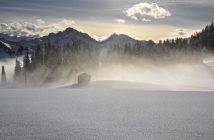Seasoned travellers will know that two peak seasons see Switzerland flooded with tourists. During the winter, they come for skiing, for apres-skiing – essentially, for snow, and all the delights each flock brings with it. In summer, the lakes and hiking draw holidayers for whom salty beaches hold no allure over crystalline waters and pristine vistas.
During my visit to Graubunden, I found it to be amply equipped with the landscape required to draw visitors during these two high seasons; from famous ski resorts St. Moritz and Davos, to the picturesque hiking trails in Stieva and Sent, the area is the perfect find for anyone with a love of the outdoors and a thing for mountains. But it also has a few surprises tucked away in its valleys that distinguish it from it’s neighbouring cantons and help it to attract a crowd year round. First, it’s outstandingly beautiful. Sound like that might not differentiate it from the rest of Switzerland? Throw in the fact that Graubunden is home to 615 lakes, 1000 mountain peaks and 150 valleys, and you get an idea of the sheer 360 degree element to the beauty. It’s, put simply, inescapably breathtaking everywhere you look.

The second pull takes a bit longer to discover, though once you’ve put your finger on it, you’ll see it everywhere: pride. The people of Graubunden are enormously proud of – and loyal to – the biggest canton in Switzerland, often returning from adventures elsewhere to settle back in its fold. In fact, the rate of repatriates is remarkable, I am told by the Grisons I meet during my adventure around Switzerland. “I left to study in Zurich,” Curdin Kindschi tells me over a glass of sparkling Rivella at a cafe a stone’s throw from Zurich Hauptbahnhof, from which I’ll catch the two hour train into the heart of Graubunden. “I go back almost every weekend – there is nowhere else in Switzerland that offers as many opportunities to hike and bike and just get outdoors and enjoy the landscape. Most of we students who are studying elsewhere in Switzerland or just across the borders in Italy or Austria go back that often – it’s not unusual at all.”
Later that day, I find myself being shown around the small Grison town of Scuol by tour guide Niculin Meyer, who is justifiably proud of the spa and its success. As in so many popular resorts, water has played a key role in the popularity of the area: “first, the fountains were built as a place to congregate, to gossip. You’ll find one in all the towns dotted in the valleys. The water was so rich with minerals that during the turn of the century it was sold as a medicine.” Now, the water still plays a role, with the huge thermal baths of Bogn Engiadina in Scuol remaining open even during low seasons due to demand.

Any potential insularity of the tight knit Grison people is offset by the outside influences that have coloured the area. Languages – and cuisines – have migrated from surrounding Italy, Germany and France and then been blended with the Romansch that’s native to Graubunden. This smorgasbord of cultures has resulted in the uniqueness of the region. Peder Benderer, pastry chef and owner of his eponymous bakery, illustrates this point: “As a sugar baker, I wanted to follow in the footsteps of my forefathers, so in 1999 I walked to Florence as they would have, learning recipes along the way. When I returned to Sent, I started to make Tuorta de Nusch – a nut pie containing walnuts, which don’t even grow in the area. Now, this is one of the most popular and well-known pies in the area – but it is a mix of Swiss and non-Swiss ingredients and techniques – like everything around here.”
Sated with sugar, I move on to Stierva for another famous Grison dish: Capuns. So famous are these Spätzle dough, beef, or in my case, vegetable-filled baked chard leaf morsels that the restaurant Belavista almost exclusively serves them – and is full to capacity most days, despite being off the beaten track and surrounded by residential houses. They’re delicious: warm, satisfying, moreish. On exiting, I meander to the car, transfixed by the immaculate houses that line Stierva with the wood piled outside in the garage for chilly evening fires and window boxes overflowing with pretty heads of flowers.

My final stop is Riom, where the Origen Festival Cultural, spearheaded by Mr. Giovanni Netzer, has become something of a local talking point. Prior to the show, we discuss the success of the festival at the cafe adjoining the castle’s theatre: “we build on it every year, and try to be different. Graubunden is full of inspiration and ideas because of the huge number of outside influences that those who loved the area have brought back in from their travels. Tonight’s piece is directed by a Spanish choreographer and dancer, Juanjo Arques, and is called Arrival, which is very apt for a place that is constantly welcoming people in.”
During the show, we watch dancers appear on the stage looking initially lost and bewildered, before grouping off happily, feet flying through the air as they find their way through their new home. It strikes me that this piece, though set in an indeterminate place, is a perfect metaphor for those who are lucky enough find themselves in Graubunden, either as a holidayer or a new inhabitant, jubilance ousting world-weariness at the sheer splendour of this enclave of Switzerland.
For more information about the canton of Graubunden, including things to see and do, visit www.graubuenden.ch.




